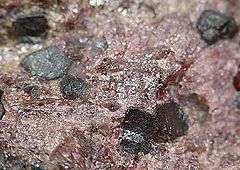Manganosite
| Manganosite | |
|---|---|
|
| |
| General | |
| Category | Oxide mineral |
| Formula (repeating unit) | Manganese oxide, MnO |
| Strunz classification | 04.AB.25 |
| Crystal system | Cubic |
| Space group |
Isometric hexoctahedral H-M symbol: (4/m32/m) Space group: F m3m |
| Unit cell | a = 4.44 Å; Z=4 |
| Identification | |
| Color | Emerald-green, becoming black on exposure to air |
| Crystal habit | Granular to massive; Octahedral crystals uncommon |
| Cleavage | Perfect on [100], [010] and [001] |
| Fracture | Fibrous |
| Mohs scale hardness | 5 - 6 |
| Luster | Vitreous, adamantine to dull |
| Streak | Brown |
| Diaphaneity | Transparent to translucent |
| Specific gravity | 5.364 |
| Optical properties | Isotropic |
| Refractive index | n = 2.16–2.17 |
| References | [1][2][3] |
Manganosite is a rare mineral composed of manganese(II) oxide MnO. It was first described in 1817 for an occurrence in the Harz Mountains, Saxony-Anhalt, Germany.[2] It has also been reported from Langban and Nordmark, Sweden and at Franklin Furnace, New Jersey. It also occurs in Japan, Kyrgyzstan and Burkina Faso.[3]
It occurs in manganese nodules. It also occurs as alteration of manganese minerals such as rhodocrosite during low oxygen metamorphism and metasomatism.[3]
References
This article is issued from Wikipedia - version of the 4/12/2013. The text is available under the Creative Commons Attribution/Share Alike but additional terms may apply for the media files.
